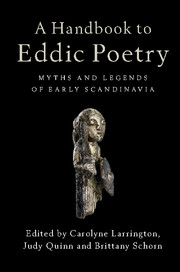Book contents
- Frontmatter
- Contents
- List of illustrations
- List of contributors
- Translations and abbreviations of the titles of eddic poems
- Introduction
- 1 The transmission and preservation of eddic poetry
- 2 Traditions of eddic scholarship
- 3 The editing of eddic poetry
- 4 The dating of eddic poetry
- 5 Eddic performance and eddic audiences
- 6 Eddic poetry and mythology
- 7 Eddic poetry and the religion of pre-Christian Scandinavia
- 8 Eddic poetry and heroic legend
- 9 Place names in eddic poetry
- 10 Eddic poetry and the imagery of stone monuments
- 11 Eddic poetry and archaeology
- 12 Eddic modes and genres
- 13 Eddic metres
- 14 Eddic style
- 15 Kennings and other forms of figurative language in eddic poetry
- 16 Alliterative lexical collocations in eddic poetry
- 17 The representation of gender in eddic poetry
- 18 The reception of eddic poetry
- Consolidated bibliography
- Index
4 - The dating of eddic poetry
Published online by Cambridge University Press: 05 August 2016
- Frontmatter
- Contents
- List of illustrations
- List of contributors
- Translations and abbreviations of the titles of eddic poems
- Introduction
- 1 The transmission and preservation of eddic poetry
- 2 Traditions of eddic scholarship
- 3 The editing of eddic poetry
- 4 The dating of eddic poetry
- 5 Eddic performance and eddic audiences
- 6 Eddic poetry and mythology
- 7 Eddic poetry and the religion of pre-Christian Scandinavia
- 8 Eddic poetry and heroic legend
- 9 Place names in eddic poetry
- 10 Eddic poetry and the imagery of stone monuments
- 11 Eddic poetry and archaeology
- 12 Eddic modes and genres
- 13 Eddic metres
- 14 Eddic style
- 15 Kennings and other forms of figurative language in eddic poetry
- 16 Alliterative lexical collocations in eddic poetry
- 17 The representation of gender in eddic poetry
- 18 The reception of eddic poetry
- Consolidated bibliography
- Index
Summary
Origins and delivery
This chapter discusses how eddic poetry is dated, and deals mainly with the poems preserved in the Icelandic manuscript Codex Regius, GKS 2365 4o (R), from around 1275, and similar poems in a few other medieval manuscripts from Iceland (see the Introduction for a discussion of how the corpus of eddic poetry is defined). The poems that are peripheral to the main corpus are nonetheless important to the question of dating. Runic inscriptions bearing similar characteristics to the poems of the Poetic Edda are preserved throughout much of Scandinavia and date from centuries before the Icelandic manuscripts were written as well as long after manuscript culture was introduced into Scandinavia. Formal similarities to Old English and Old High German poems, such as Beowulf and the Hildebrandslied, are also relevant to the history of eddic poetry. The basic verse couplet of the Old Norse metre fornyrðislag is paralleled in the metrical form of these poems, which present comparable content in their tales of past heroes. Thus the use of fornyrðislag in a certain poem indicates a considerable range of possibilities: the poem could be as old as the manuscript, or it could be much older; it may originate in Iceland or elsewhere in Scandinavia, or perhaps in a Scandinavian colony abroad. For different views on the age and origin of eddic poetry in the history of eddic research, see Harris, Chapter 2 in this Handbook.
Since the aim in dating eddic poetry is usually to determine the age of the original composition, the transmission of the poems presents a major complication. Eddic poems are rarely associated with named poets or historic events that refer to the moment of composition. It is possible to approach the stages of written transmission in an empirical way when a poem exists in two or more versions thought to derive from a common written exemplar, such as the poems preserved in both R and AM 748 I a 4o (A). In general, however, the oral transmission of eddic poetry presents fundamental methodological challenges for the reconstruction of past versions. Different extant versions of some eddic poems are regarded by many to be independent oral variants: the most famous examples are Vǫluspá (see Quinn 1990b and 2016) and the sequence of stanzas known as Hjálmarr's Death-Song (Lönnroth 2011a [1971: 191–218]).
- Type
- Chapter
- Information
- A Handbook to Eddic PoetryMyths and Legends of Early Scandinavia, pp. 72 - 91Publisher: Cambridge University PressPrint publication year: 2016
- 4
- Cited by



